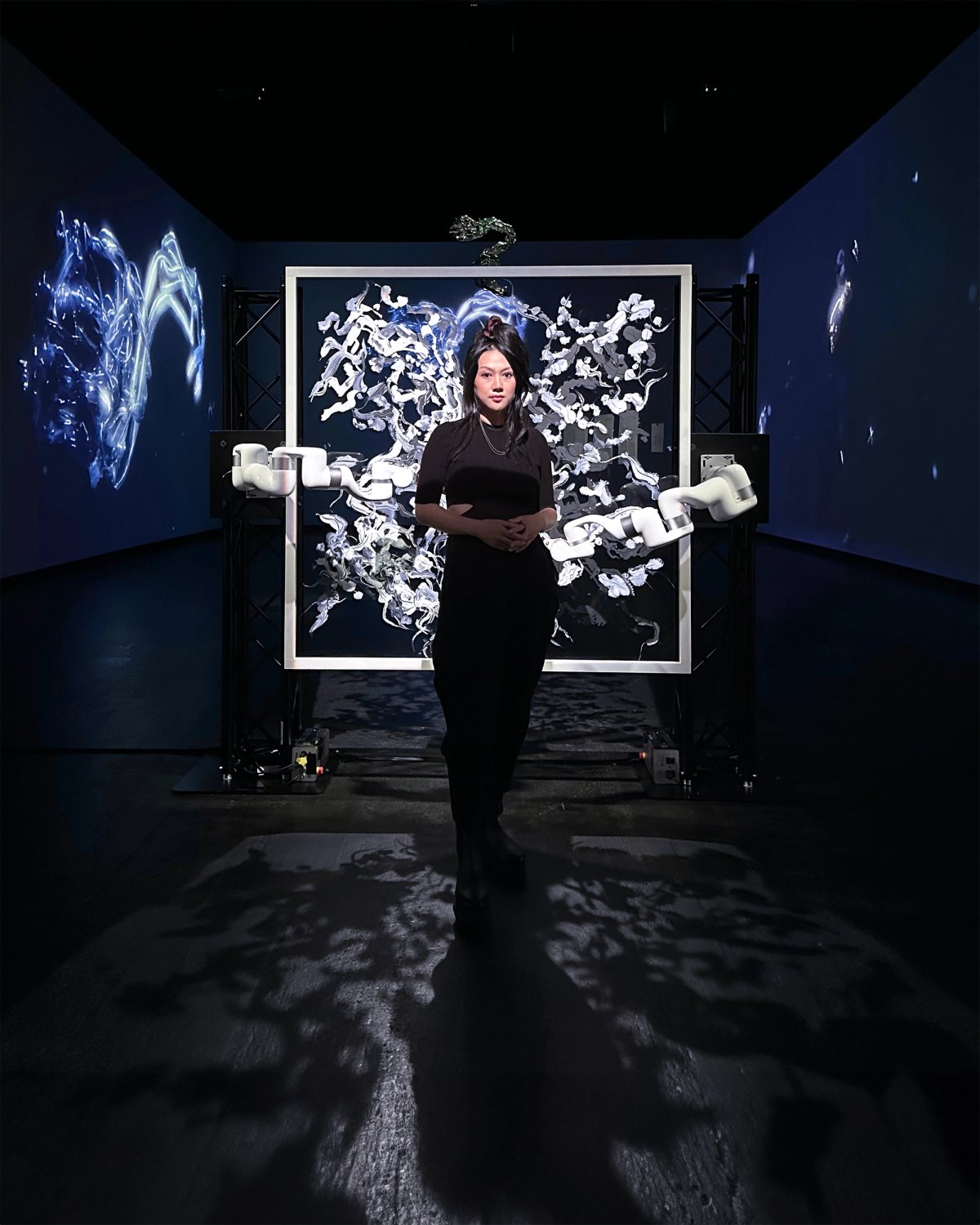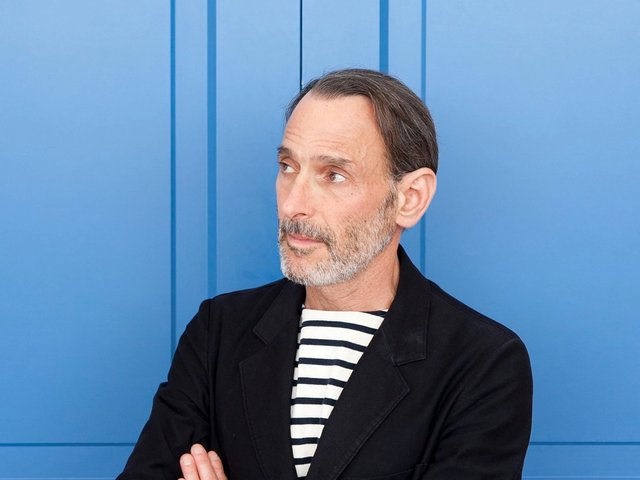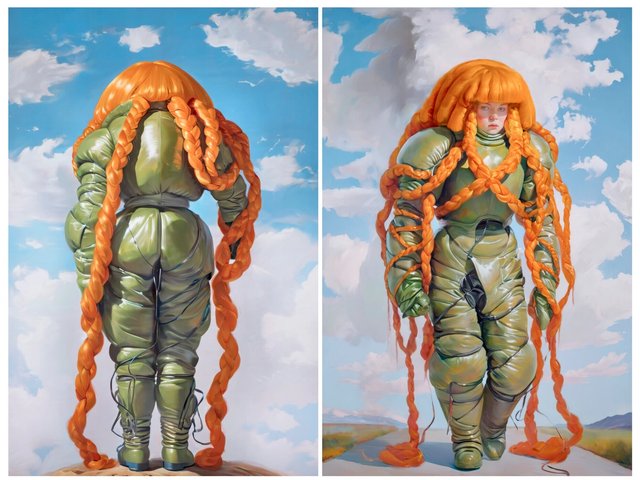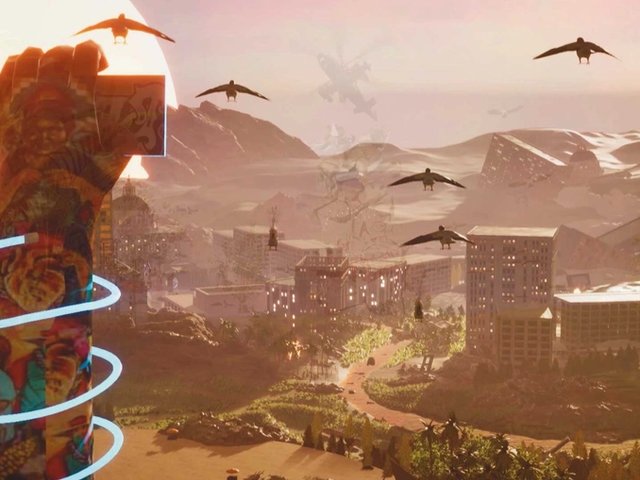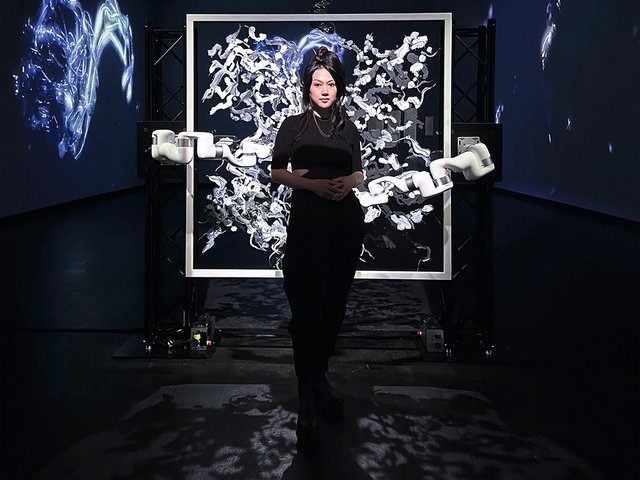Sougwen Chung is one of the most compelling artists working with artificial intelligence (AI) today. As part of the arts and culture programme at the 2025 annual meeting of the World Economic Forum, she is presenting Spectral, a groundbreaking kinetic installation using an AI trained on records of the artist’s painting stroke data to link biofeedback from the artist’s brainwaves to robotic painting arms. Spectral links to the artist’s brainwaves, translating thoughts into delicate, painterly, movements across a transparent canvas.
Chung, a Chinese Canadian artist and researcher into human-machine collaboration, tells The Art Newspaper that her journey with computation began almost 15 years ago. “Back then, I was exploring essential questions: ‘What does it mean to co-create with a machine? Where does It end and I begin?’ As a researcher at MIT Media Lab [in Boston], I embarked upon this by collecting two decades of drawings to train a recurrent neural network.” That project, Memory (2017), was acquired by the Victoria and Albert Museum in London in 2022, becoming the first AI model to be collected by a leading cultural institution.
Chung is returning to WEF after speaking as a cultural leader at the forum’s “summer Davos”, the 2023 Annual Meeting of the New Champions (AMNC), in Tianjin, China. Since June 2023, she says, “I’ve been incubating several projects in unison, including… Spectral.” She will be premiering “Oscillation 2” of Spectral at Davos.
It is, she says, “a new movement that I have developed specifically for the WEF. One invigorating aspect of the process is that Spectral showcases the stage of my own meditative development. It is a reinforcement loop that manifests between the robotic painting and my own biofeedback. It hones in my brainwave signal to focus on the alpha state—which is the state of creative flow. My flow state [becomes] more adaptive in each oscillation, and my alpha levels are higher. That process is the art itself.
“It’s an immense privilege to be a part of the arts and cultural contribution at Davos,” Chung says. “The arts and culture strand is part of a larger movement… that believes that artistic practice is not just a reflection of our times but a vital force in shaping the critical issues of our times.”
Spectral, Chung says, “is the latest stage of DOUG (Drawing Operations Unit: Generation 1-6), a decade-long project exploring human and machine mark-making.” She says she hopes the work “ inspires viewers to understand that categories are permeable and porous. Subjects like ‘human’, ‘machine’, ‘artificial/natural’ and ‘intelligence’—all of these are not fixed points but ideas to be reinvented and reinvigorated.”
Spectral comes, she says, “from a deep interest in the human hand and its evolution in the context of technological and social change. A painting is not just a painting. It is material documentation of the hand in motion. The hand is a locus of muscle memory and physical instinct that drives the creative process, operating at multiple layers of perception and intentionality. It began with the robotic arms I incorporate in my work, mimicking and interacting with my hand movements—it’s led to extended proprioception [body awareness] through live bio-signal. Through these robots, I develop different relational modes of humans and machines… What becomes of our own sensory apparatus when interlaced with machine input?”
“How can the hand and body be implicated in new and uncanny ways?” she says. “How can these questions help shape our understanding of ourselves and the world around us—the world to come?”
Robotics and a new creativity
Chung sees her work with robotics as a means to renewing artistic creativity. “Sometimes,” she says, “there is a thread of discourse around technology replacing human artistic labour. However, the potential of invigorating artistic tradition through technological development is still in its early stages.”
“I’m inspired to be part of the larger conversations which will take place at Davos,” Chung says, “such as the role of art in shaping the future, the impact of technology on creativity, and the potential of artistic practice in addressing global challenges.”
Reflecting on collaboration in “the age of intelligence”, Sougwen says that “Intelligence is multifaceted. In previous generations, intelligence was understood as more explicitly tied to human intelligence, but that was only a product of the limitations of our view. Over the past decades, we’ve seen an explosion in what we understand intelligence is and can be. Intelligence is not local; it’s not even global. It’s planetary, it’s multi-species, it’s multi-agential, it’s multi-temporal. From the microbial to the planetary, intelligence is teeming; we must know how to look for it.”


